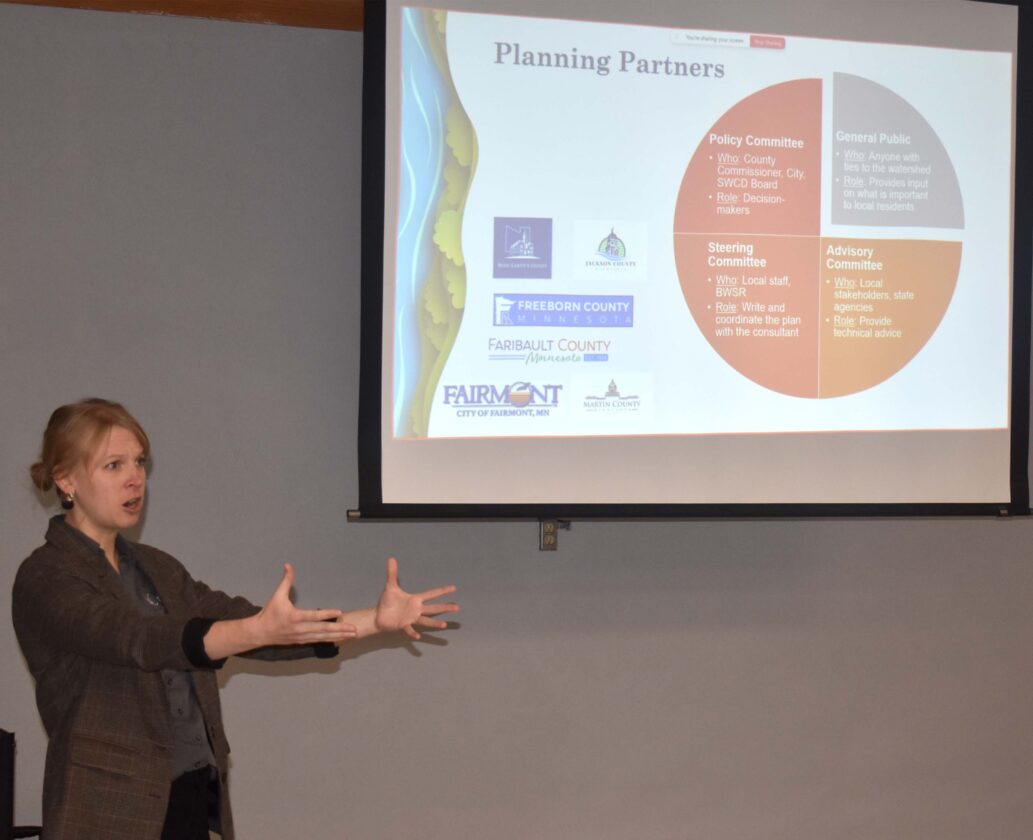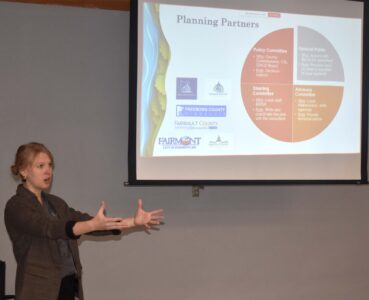Committee OKs watershed plan after yearlong process

ABOVE: Water Quality Scientist and Watershed Planner from Houston Engineering Rachel Olm speaks on the Blue Earth River Watershed Plan at a planning committee meeting in the Blue Earth Ag Center on Monday. After no public comment, the plan was approved unanimously by the committee to be sent to local boards and the Minnesota Board of Water and Soil Resources (BWSR).
BLUE EARTH – After a public hearing for comments, the Blue Earth River Watershed Plan was approved by its planning committee at the Blue Earth Ag Center on Monday.
The Blue Earth River Watershed Plan includes some or all of Martin, Faribault, Blue Earth, Cottonwood, Freeborn, Jackson and Watonwan counties, totaling over 1 million acres of land, of which 86 percent is cropland.
The plan itself was presented by Water Quality Scientist and Watershed Planner from Houston Engineering Rachel Olm. The One Watershed, One Plan was described by Olm as a way to move forward with everyone collaborating.
“It transitions from the way that local water was historically done,” she said. “One that was traditionally done on local jurisdictional boundary lines, to something that is planned on more of a major hydrologic [scale].”
Collaboration between county government and conservation officials, as well as city representatives, was necessary to unite everyone for one consistent plan. Attendees of the meeting included commissioners and soil and water conservation district representatives from all counties included and Fairmont’s Water Resources Coordinator Hannah Neusch.
Olm said public involvement in this plan has been crucial, starting with a public event in May 2024 at the Chain of Lakes Yacht Club in Fairmont. Since then, multiple surveys have been conducted, and the information from them has been sent to the watershed plan’s various committees.
From there, the committees have sought to establish measurable goals by January 2025, develop an implementation schedule by March, describe implementation programs and plan administration by April and finalize the plan with an informal review by July. With all of that completed, they are at the final stage of a formal review, public hearing and consideration for approval.
This final plan was given to the public and review authorities with 60 days for them to comment on the plan. Olm said what they received was supportive in nature and assisted in how to best meet policy requirements for plan approval by the Minnesota Board of Water and Soil Resources (BWSR).
“We need to make sure we’re checking the boxes from a policy and statutory responsibility perspective,” Olm said. “Now the plan has been revised based off of those comments that came in during the formal review period.”
The current plan identified several high-priority issues for funding that come from the watershed and overall projects. This includes erosion of streams, ravines and shoreline, sedimentation, nutrient loading, soil health, flood damage reduction, maintenance and repair of drainage systems and protection of surface drinking water sources.
One example Olm gave for nutrient loading is Budd Lake in Fairmont. She said it has struggled in recent times with nitrates exceeding the drinking water standards. Overall, Olm said 13 lakes and one stream in the Blue Earth River Watershed have nutrient impairments.
The plan listed 21 lakes in the watershed where they want to make a definitive change within the next 10 years. Under Natural Environment Lakes, the plan lists the Martin County lakes of East Chain, Iowa, Clam, Cedar, Watkins and Fish as priorities.
Under General and Recreational Development, all 10 lakes for protection or restoration are in Martin County. Under protection, due to no known impairments for nutrients or inconclusive data, are South Silver and Imogene. Fox, George, Sisseton, Budd, Hall, Amber, Big Twin and Wilmert were included under restoration, as they have been found to be impaired for excess nutrients.
The 10 year goal for these lakes with excess nutrients is to reduce total phosphorous loading and nitrogen loading by 4 percent.
“Those are really large mass reductions based off of implementation efforts that are anticipated,” Olm said. “Where that number came from is we wanted to try to align as much as possible with 10 year state agency targets.”
Other issues included under medium priority include bacteria loading, aquatic invasive species, stormwater runoff, wildlife habitats, aquatic connectivity, groundwater contamination and groundwater supplies.
After the presentation, the floor was opened for public comments on the project, but no one from the public attended the meeting.
The board then took a vote to send the current watershed plan to the BWSR, as well as to local boards within the watershed area for approval. The vote was passed unanimously, and as long as no issues are found by local boards and the BWSR, the Blue Earth River Watershed Plan has been finalized.
For questions, email rolm@houstoneng.com



